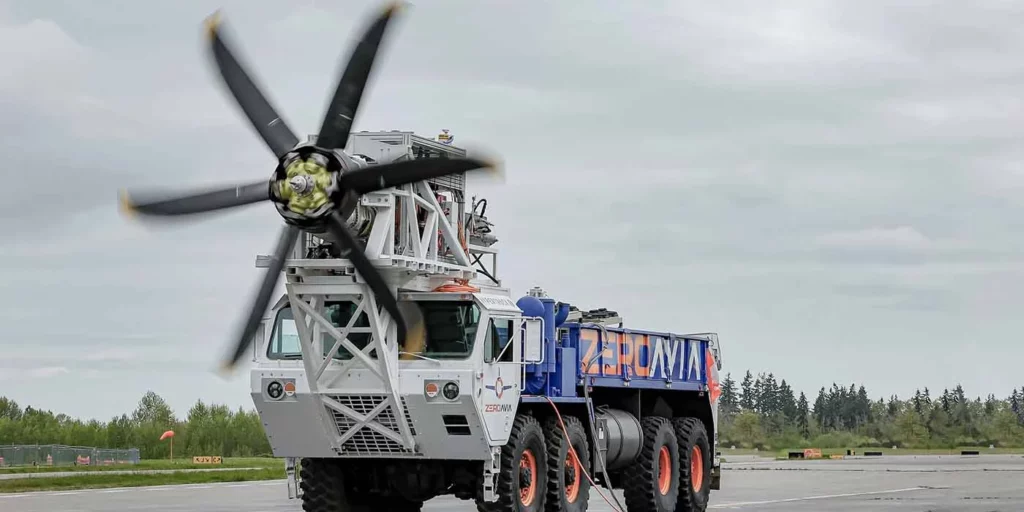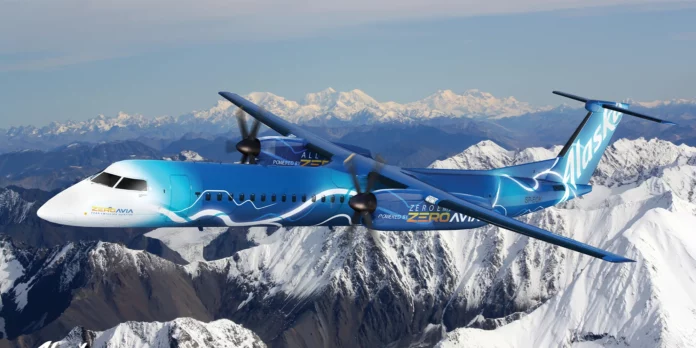A partnership between Alaska Airlines and ZeroAvia will retool a decommissioned 76-seat Q400 aircraft, making it the largest zero-emissions plane in the world.
Earlier this month, U.S. Representative Suzan DelBene, Washington Governor Jay Inslee, and Dave Somers, the Executive of Snohomish County, converged in Everett, Washington, at the ZeroAvia Paine Field research and development location.
They were all there to join forces with ZeroAvia and Alaska Airlines’ top executives to kick-start the transformation of a Bombardier Q400 regional turboprop into a hydrogen-electric propulsion system-powered aircraft. This joint endeavor aims to bolster the introduction and acceptance of zero-emission aviation technologies. The aviation sector is responsible for about 2.5 percent of all CO2 emissions and 3.5 percent when considering all non-CO2 climate impacts, according to Our World In Data.

The decommissioned Horizon Air 76-seat Q400 aircraft was handed over to ZeroAvia — a pioneer in the creation and production of hydrogen-electric aircraft propulsion mechanisms. Horizon Air is the regional subsidiary of Alaska Airlines.
“Our state has a rich history of leadership in aerospace and we’re proud to be at the center of a technological revolution in zero-emission flight,” Governor Inslee said. “Through innovation and partnerships like the one demonstrated today, we can help write the next chapter of aviation history right here in Washington State.”
During this event, ZeroAvia introduced its cutting-edge 1.8MW multi-megawatt modular electric motor system, demonstrated via a propeller spin on the company’s 15-ton HyperTruck ground-test rig. This trailblazing electric motor technology, along with high-temperature PEM fuel cells and sophisticated power electronics, is a vital component in the development of commercially feasible hydrogen fuel cell engines for larger aircraft.
“This is a great step forward in aviation innovation, to help create a new future of flight – right here at home,” Ben Minicucci, the CEO of Alaska Airlines, said during the event, highlighting the necessity for novel technologies to achieve long-term net-zero carbon emissions. He showed enthusiasm about partnering with ZeroAvia to bring zero-emission aviation options to life. In honor of this innovative alliance, the aircraft was given a new paint job.

The fusion of ZeroAvia’s powertrain with the Dash 8-400 airframe will create a commercially viable zero-emission aircraft. The aircraft will be powered by hydrogen fuel cell engine technology, which is five times more potent than any existing system.
ZeroAvia’s Founder and CEO, Val Miftakhov, said such an accomplishment would have been unthinkable just a few years ago. “Launching this program puts us on track for a test flight next year, and accelerates our progress toward the future of zero-emission flight for Alaska Airlines and for the world at large,” he said.
ZeroAvia’s groundbreaking work enables the Q400, or Dash 8-400, to potentially take flight and fast-track the certification process for the ZA2000 propulsion system. The company has already made headlines with its prototype 600kW hydrogen-electric engine, the ZA600, and a 250kW system, which was the largest of its kind when it was tested.
The hydrogen-electric engine from ZeroAvia employs fuel cells to transform hydrogen fuel into electricity, which then powers the electric motors that spin the aircraft’s propellers. The certifiable ZA2000 system will incorporate high-temperature PEM fuel cells and liquid hydrogen fuel storage, crucial for the commercial operations of large regional turboprops. ZeroAvia has also established a partnership with De Havilland of Canada, the original producer of the Dash 8 aircraft, to share data and expertise.

In 2021, Alaska Airlines, the fifth-largest US airline, teamed up with ZeroAvia to back the development of zero-emission propulsion technology for regional aircraft. This positions Alaska Airlines favorably to promote the progression of zero-emission technology within the industry.
Congresswoman DelBene that as the state works to meet its emissions reduction goals, it must prioritize decarbonizing the commercial transportation sector. “Washington state is leading the nation in developing and deploying clean energy technologies and the Alaska Airlines-ZeroAvia partnership is a prime example,” she said. “This collaboration could revolutionize the aviation industry to make our planes greener and our skies cleaner.”
The U.K.-based ZeroAvia is a leader in zero-emission aviation, focused on hydrogen-electric aviation. It set a 2025 target for a 300-mile range in a 9–19 seat aircraft and aims to achieve up to a 700-mile range in 40–80 seat aircraft by 2027.
Related on Ethos:


